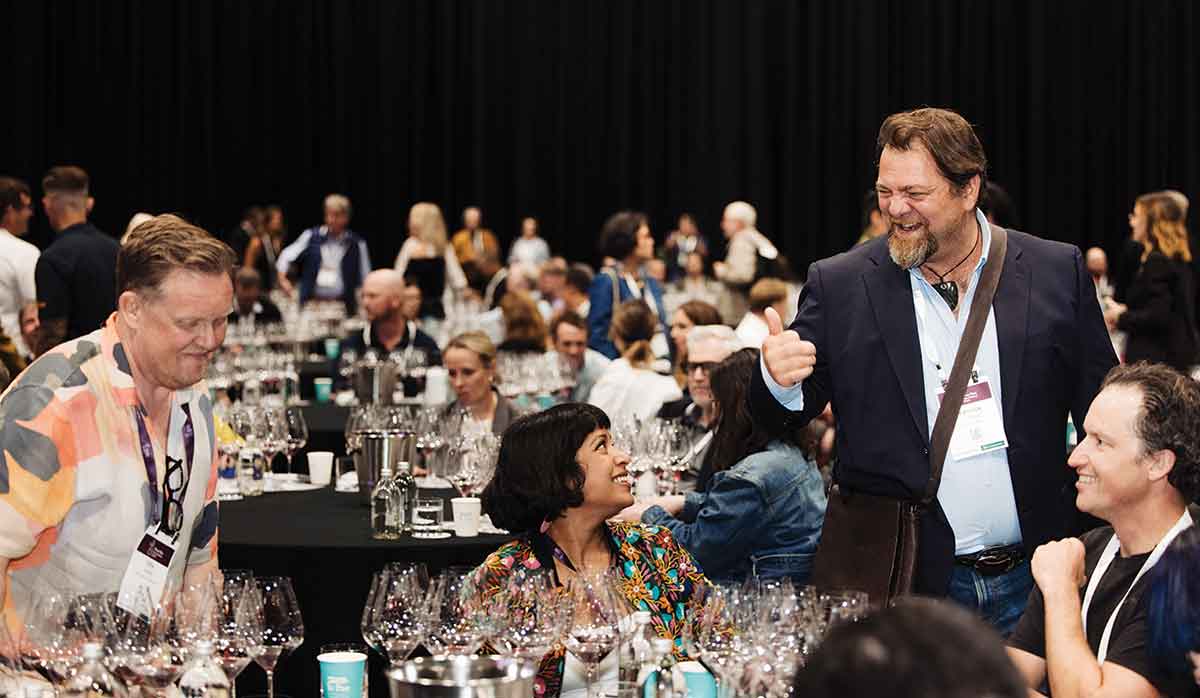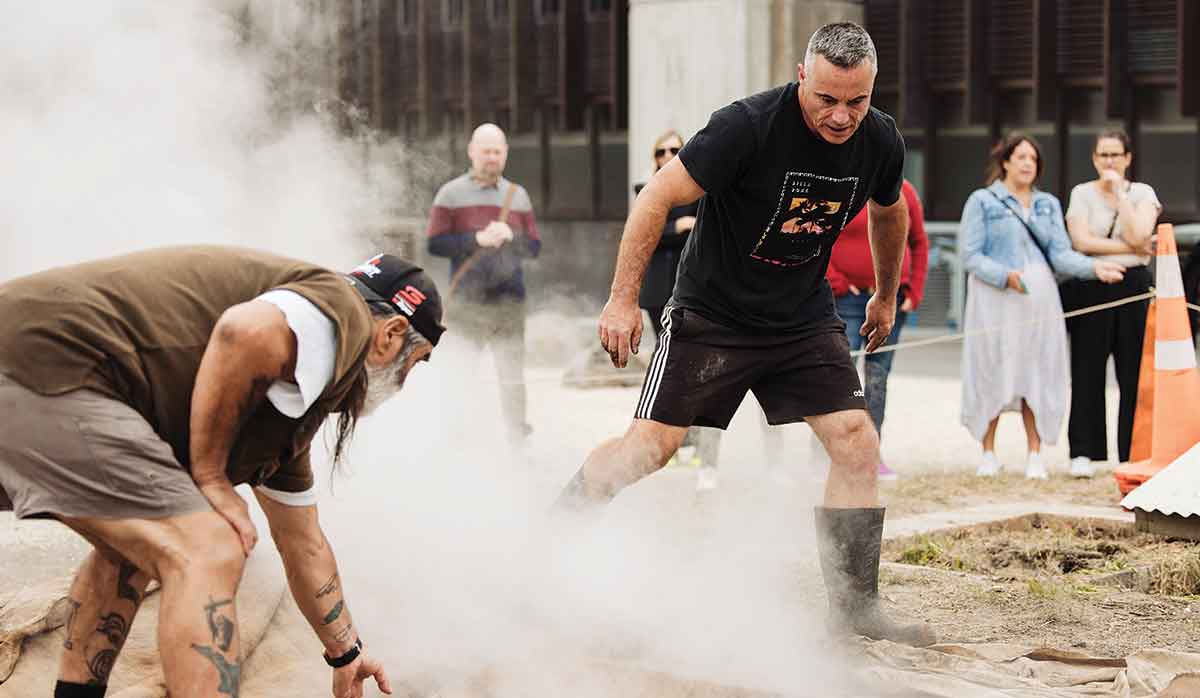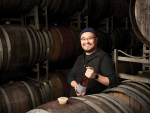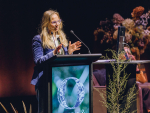The three days of plenary sessions and tastings were a platform for discussions about quality and style evolution, as well as the deepening expression of regional and subregional identities. Emma Jenkins MW shares some of the takeaways from international guests, following their immersion into New Zealand Pinot Noir.
Pinot Noir New Zealand 2025 was a timely reminder of how far our Pinot Noir has come and the opportunities that lie ahead. A common sentiment among international guests who attended the event in Ōtautahi Christchurch in February, and also visited New Zealand wine regions, was the shift towards greater finesse, balance, and expressiveness. United Kingdom writer and speaker Dr Jamie Goode was struck by how the wines have developed since his last visit in 2019. "Pinot now seems to be more nuanced," he observed. "It's my impression that winemaking is a little looser, in a good way - free of technical obsession that can lead many of the wines into the same sort of flavour space."
International consultant Madeleine Stenwreth MW also noticed this movement. "When I first started communicating about New Zealand wines more than 10 years ago, I wasn't really sure I understood what your Pinot Noir was about because it was so eager to impress - dark, extracted, lots of sweet oak. But producers today are so much more confident with their vineyards and don't feel the need to push so hard to prove themselves. They are showing much more place, much more vineyard."
United States-based Christina Pickard, Wine Enthusiast's New Zealand reviewer, agrees. "Going into the conference, I thought I had a good grip on the Pinot scene, but it turns out, like most things in life, I was only scratching the surface," she laughs. "The multitude of in-depth tastings demonstrated how far your Pinot has come in a relatively short time. Across the board wines were balanced, made with intent and with a sense of place, helping me to gain a much deeper understanding of subregionality."
While the refinement in style was widely praised, some challenges remain. Christina noted some producers are still working to "wrangle tannins into submission", while Canadian educator and writer Jacky Blisson MW commented that the pervasiveness of whole cluster fermentation could sometimes lead to wines with dominant herbal tannins or lacking individuality, though she too appreciated the increasing sophisitication. "Like many Pinot-producing regions, there is a clear shift in style to greater restraint and finesse now. Less extraction, less heavy oaking, less jammy fruit - overall better balance and grace."
Tūrangawaewae
Australian consultant sommelier Liinaa Berry felt that the deepening confidence amongst winemakers stood out as "leaning into regional and site-specific expressions rather than making wines to fit external expectations. There's more transparency, more tension, and a real refinement in oak and extraction. It was clear that winemakers are letting go of any pressure to emulate other regions and are instead embracing what their land naturally gives them."
A topic of discussion at the Regional Road Trip tastings, where producers showcased both current and older vintages, was the ageability of New Zealand Pinot Noir. Singapore-based wine communicator and 67 Pall Mall Asia Head of Wine, Richard Hemming MW, emphasised that while New Zealand Pinot has gained significant respect internationally, there is an opportunity to further solidify its standing through the showcasing of mature vintages. "Capacity to age is a vital credibility factor on the global stage. Showing mature wine is one way to really turn the heads of Pinot lovers because there is already so much competition for good young Pinot." Richard pointed out that most New Zealand Pinot Noirs available internationally are young, while Burgundy and other leading Pinot regions have established reputations for longevity. Making more aged wines available could help position New Zealand Pinot more favourably in the global market.
 |
|---|
|
Australian consultant sommelier Linaa Berry at one of two Major Tastings
|
He Tangata
Beyond the wines themselves, our people and community were seen as a defining strength. UK wine writer and presenter Olly Smith was particularly taken by the way Māori culture was interwoven with winemaking stories, reinforcing a deep sense of connection to the land. Olly described his experience at the event as transformative, leaving him with a profound appreciation for the people behind the wines. "Absolutely inspiring," he enthused. "The concept of whenua felt like an invitation and an empowering binding to the place where we come from, the place we belong to, the place where we can stand. The wines I tasted lit me up with this."
Madeleine agreed, with a caveat: "It is beautiful and respectful, giving an understanding of New Zealand, but take care you don't lose the wine message; the focus on the hard work that has been done in the vineyards and wineries." Jacky encouraged winemakers to move away from overly technical descriptions when communicating with consumers and the trade. “The soils and climate, the sustainability commitments, the threading in of Māori concepts like turangawaewae are all essential parts of what makes New Zealand wine unique,” she says. “But what truly brings all of the above to life is the people behind the wines.”
Kaitiakitanga
“Living wine was a great focus,” Olly says. “It’s something to shout about as we face the climate emergency together and try to persuade our collective audiences that wholesome investment in the wine they choose to drink is truly priceless.”
Liinaa found Jamie’s regenerative viticulture presentation particularly impactful, with the ideas seen in practice in vineyards she visited afterward. “Seeing firsthand how growers are moving from sustainability toward true regeneration—prioritising soil health, biodiversity, and resilience—made me realise that New Zealand isn’t just adapting to change, but actively shaping the future of winegrowing.” Being a custodian of the land “isn’t just a nice concept in New Zealand”, she says. “It’s a responsibility woven into the country’s cultural fabric. That kind of awareness changes the way you see wine."
Despite the energy of the conference, Blisson pointed out a slightly disheartening contradiction. “The enthusiasm of the Pinot producers at the conference was palpable and very exciting to witness. So much talent, potential, and time invested to promote Pinot; yet there remains a question mark over its future plantings and expansion.”
 |
|---|
|
The modern hangi prepared by chef Monique Fiso and her team was an extraordinary start to a conference elevated by manaakitanga.
|
Keynote speaker Eric Asimov, of The New York Times, highlighted the lack of visibility of New Zealand Pinot Noir in key markets like the US. In his presentation, Eric said that while he believed in the potential of New Zealand Pinot Noir, the wines remain hard to find on shelves and wine lists. “Potential and possibility don’t create awareness. New Zealand needs some charismatic importers and distributors to champion these wines.”
Ā Mua
New Zealand Pinot Noir has never been more compelling and reflective of place. There is a growing recognition of their age-worthiness, our unique culture and terroir and the importance of sustainability in shaping the future of New Zealand viticulture. However, challenges remain in ensuring these wines are accessible and properly championed in global markets.
New Zealand Pinot Noir is at an exciting crossroads. The place, passionate producers, and ever-evolving styles captured the attention of international visitors, and these same ingredients will captivate wine lovers worldwide – so long as the world gets a chance to do so. Events such as Pinot Noir New Zealand 2025 are an important part of making that happen. “Before the conference, I saw New Zealand Pinot as a category with potential, still finding its unique voice,” Liinaa says. “Afterwards, I see it as something far more significant, not just evolving stylistically, but part of a much larger, more meaningful movement. New Zealand is redefining what wine can and should be in a changing world.”
Olly says he came into it as a fan, “and left with my heart in your hands”. He has long bought, recommended, shared and enjoyed New Zealand Pinot Noir, and has visited “this great-spirited country” several times, he says. “I’ve returned to the UK feeling like a portal has been opened to your world-class Pinot Noir on a level that I could barely have dreamt of... and that open portal has travelled home with me.”














